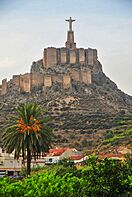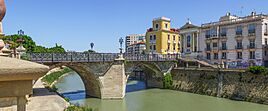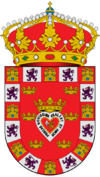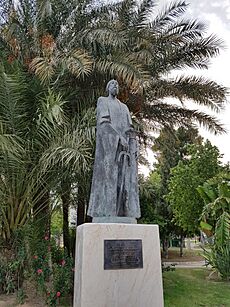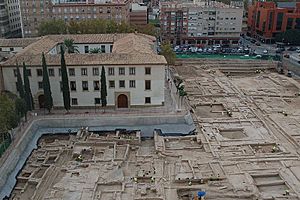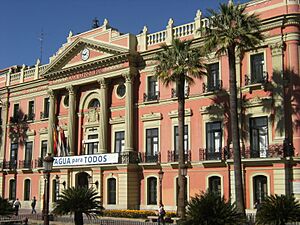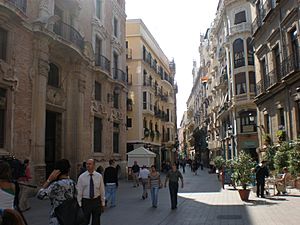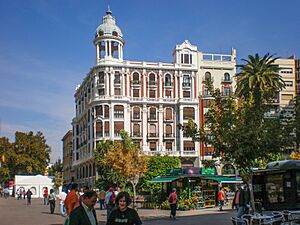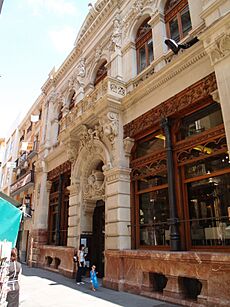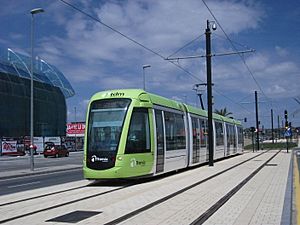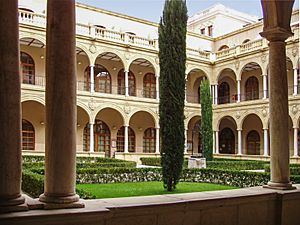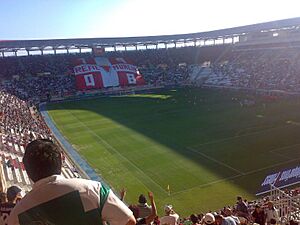Murcia facts for kids
Quick facts for kids
Murcia
|
|||
|---|---|---|---|
|
|
|||
|
|||
| Country | Spain | ||
| Autonomous community | Region of Murcia | ||
| Founded | 825 AD (by Abd ar-Rahman II) | ||
| Area | |||
| • Municipality | 881.86 km2 (340.49 sq mi) | ||
| Elevation | 43 m (141 ft) | ||
| Population
(2021)
|
|||
| • Municipality | 460,349 | ||
| • Density | 547/km2 (1,420/sq mi) | ||
| • Urban | 672,773 | ||
| Demonym(s) | Murciano/a | ||
| GDP | |||
| • Metro | €29.720 billion (2020) | ||
| Time zone | UTC+1 (CET) | ||
| • Summer (DST) | UTC+2 (CEST) | ||
| Postal code |
30001 to 30012
|
||
| Dialing code | 968 / 868 | ||
Murcia is a big city in south-eastern Spain. It is the capital and largest city of the Region of Murcia, which is like a state or province in Spain. It is also the seventh largest city in the whole country. In 2021, about 460,349 people lived there. If you include the nearby towns, the total population is over 672,000 people.
Murcia is located on the Segura River, in the southeast part of Spain. It has hot summers and mild winters. It doesn't rain very much there.
The city was started in 825 AD by Abd ar-Rahman II, who was a ruler of Cordoba. He called it Mursiyah. Today, Murcia is known as a city for services and a university town. Visitors enjoy seeing the Cathedral of Murcia and other beautiful old buildings. It's also famous for its food, its Holy Week procession, and the Fiestas de Primavera (Spring Festival).
Murcia is often called "Europe's orchard." This is because it has a long history of farming. It grows and exports lots of fruits, vegetables, and flowers.
Contents
- Murcia's Story: A Look Back in Time
- Where is Murcia? Its Land and Rivers
- Who Lives in Murcia? Population Facts
- Must-See Places in Murcia: Top Sights
- Murcia's Fun Times: Festivals and Celebrations
- Murcia's Economy: Farming, Tourism, and More
- Getting Around Murcia: Transport Options
- Staying Healthy in Murcia: Healthcare
- Learning in Murcia: Education
- Famous People from Murcia
- Murcia's Sports Teams
- Murcia's Sister Cities
- Images for kids
- See also
Murcia's Story: A Look Back in Time
People have lived in the Murcia area since ancient times, even before history was written down. During the Bronze and Iron Ages, different groups of people lived here. There are also signs that Romans lived in the area a long time ago.
Many people think Murcia's name comes from the Latin word myrtea, which means "land of the myrtle plant." Myrtle plants grow a lot in this area. Another idea is that it comes from Murtia, meaning "Murtius Village," named after a common Roman name. Some also believe it comes from the Latin word Murtae, meaning "Mulberry," because mulberry trees were common. The Latin name eventually changed to the Arabic Mursiya, and then to Murcia.
The city we know today was founded in 825 AD. It was called Madinat Mursiyah by Abd ar-Rahman II, the emir of Cordoba. Smart planners used the Segura River to create a clever system of water channels. This helped the city's farms grow and become very successful. In the 12th century, a traveler named Muhammad al-Idrisi said Murcia was a busy and well-protected city.
After a big empire fell in 1031, Murcia became its own kingdom for a while. It was a very rich city, famous for its pottery, silk, and paper. Murcia's coins were even used as a model across Europe! Famous thinkers like Ibn Arabi and the poet Ibn al-Jinan were born here during this time.
In 1172, a group from North Africa called the Almohades took over Murcia. Later, as Christian armies started to take back Spain, Murcia became a small Muslim kingdom from 1223 to 1243. In 1243, the Christian king Ferdinand III of Castile made Murcia a protected area. This gave Castile access to the sea and protected Murcia from other kingdoms. Many Christians moved to Murcia, making them the main group of people.
This led to a Muslim uprising in 1264. James I of Aragon stopped the revolt in 1266, taking over Murcia and bringing people from Aragon and Catalonia to live there.
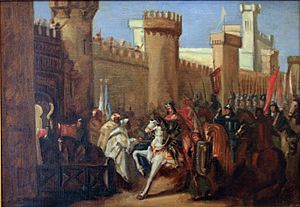
Later, during the time of King Alfonso X of Castile, Murcia was one of his important capital cities, along with Toledo and Seville.
Because of its mixed population, Murcia was conquered again by James II of Aragon in 1296. Finally, in 1304, Murcia became a permanent part of Castile through a treaty.

Murcia's wealth decreased as trade routes moved from the Mediterranean Sea to the oceans. Wars also affected it. The city faced hard times in the 14th century because it was on the border with the Muslim kingdom of Granada. But it became rich again after Granada was conquered in 1492 and especially in the 18th century, thanks to a boom in the silk industry. Many of the city's famous churches and buildings today are from this period.
In 1810, French troops looted Murcia. Then, in 1829, a big earthquake hit, causing many deaths and problems. After that, there were also outbreaks of plague and cholera.
The city and its surrounding areas also suffered from bad floods in 1651, 1879, 1946, and 1948. A special wall called a levee was built to help stop the Segura River from flooding. A popular walking path, the Malecon, runs along the top of this wall.
Since 1833, Murcia has been the capital of its province. In 1982, it also became the capital of the Region of Murcia. Since then, it has grown to be the seventh most populated city in Spain and a busy city for services.
A 5.1 magnitude earthquake shook the Region of Murcia on May 11, 2011. Nine people died, and over 400 were hurt.
Where is Murcia? Its Land and Rivers
Murcia is located in a flat, fertile area called the huerta (which means orchard or vineyard). The Segura River and its smaller branch, the Guadalentín, flow through this area. The city is about 43 meters (141 feet) above sea level. The whole city area covers about 882 square kilometers (341 square miles).
The most famous part of Murcia's landscape is its orchard areas, full of farms. Besides farms and city areas, there are also dry lands, pine forests in the mountains, and semi-dry regions to the south. A large natural park, the Parque Regional de Carrascoy y el Valle, is just south of the city.
The Segura River: Murcia's Lifeline
The Segura River flows through a flat plain called the Vega Media del Segura. The river usually has a small amount of water. However, it is known to cause floods sometimes. The city was flooded in 1946, 1948, 1973, and 1989.
Mountains and Hills Around Murcia
The Segura River valley is surrounded by two mountain ranges. To the north are the hills of Guadalupe, Espinardo, and Monteagudo. To the south is the Cordillera Sur. These southern mountains divide the city area into two parts: the Field of Murcia (south of the mountains) and the Orchard of Murcia (the Segura Valley to the north). Near the center of the plain, the steep hill of Monteagudo stands out.
Murcia's City Areas: Districts and Neighborhoods
Murcia's large area of 881.86 square kilometers (340.49 square miles) is made up of 54 pedanías (suburban districts) and 28 barrios (city neighborhoods). The neighborhoods make up the main city area, which is about 12.86 square kilometers (4.97 square miles). The historic city center is about 3 square kilometers (1.2 square miles) of the downtown area.
| District | Population (2021) |
|---|---|
| La Albatalía | 2,122 |
| La Alberca | 12,998 |
| Algezares | 5,717 |
| Aljucer | 7,761 |
| Alquerías | 6,286 |
| La Arboleja | 2,111 |
| Baños y Mendigo | 847 |
| Barqueros | 1,040 |
| Beniaján | 11,373 |
| Cabezo de Torres | 13,560 |
| Cañada Hermosa | 189 |
| Cañadas de San Pedro | 371 |
| Carrascoy | 104 |
| Casillas | 4,995 |
| Churra | 8,731 |
| Cobatillas | 2,701 |
| Corvera | 2,808 |
| Los Dolores | 5,189 |
| Era Alta | 3,251 |
| El Esparragal | 7,920 |
| Garres y Lages | 7,673 |
| Gea y Truyols | 1,251 |
| Guadalupe | 7,344 |
| Javalí Nuevo | 3,223 |
| Javalí Viejo | 2,292 |
| Jerónimo y Avileses y Balsicas de Arriba | 1,787 |
| Lobosillo | 1,893 |
| Llano de Brujas | 5,639 |
| Los Martínez del Puerto | 810 |
| Monteagudo | 4,036 |
| Nonduermas | 2,496 |
| La Ñora | 5,099 |
| El Palmar | 24,163 |
| Puebla de Soto | 1,836 |
| Puente Tocinos | 16,811 |
| El Puntal | 7,201 |
| El Raal | 6,385 |
| Los Ramos | 3,473 |
| La Raya | 2,255 |
| Rincón Beniscornia | 980 |
| Rincón de Seca | 2,251 |
| San Benito | 14,609 |
| San Ginés | 2,798 |
| San José de la Vega | 5,019 |
| Sangonera la Seca | 5,773 |
| Sangonera la Verde | 12,040 |
| Santa Cruz | 2,633 |
| Santiago y Zaraiche | 11,044 |
| Santo Ángel | 6,374 |
| Sucina | 2,314 |
| Torreagüera | 9,305 |
| Valladolises y Lo Jurado | 790 |
| Zarandona | 7,020 |
| Zeneta | 1,847 |
| Murcia (town centre) | 169,631 |
| Total | 460,349 |
Murcia's Weather: Hot Summers, Mild Winters
Murcia has a hot semi-arid climate. This means it has mild winters and very hot summers. This is because it is located inland, away from the cooling effect of the sea. It gets sunshine for more than 320 days a year. Sometimes, Murcia can have very heavy, sudden rainstorms.
In January, the coldest month, the average temperature is about 16.6°C (61.9°F) during the day and 4.7°C (40.5°F) at night. It might freeze at night in most winters, but snow is very rare. Snow has fallen and stayed in Murcia only a few times in the last century. In August, the warmest month, temperatures range from 34.2°C (93.6°F) during the day to 20.9°C (69.6°F) at night. Temperatures often reach or go above 40°C (104°F) at least once or twice a year. The highest temperature ever recorded in Murcia was 46.2°C (115.2°F).
| Climate data for Murcia (1984–2010), extremes (1984–) | |||||||||||||
|---|---|---|---|---|---|---|---|---|---|---|---|---|---|
| Month | Jan | Feb | Mar | Apr | May | Jun | Jul | Aug | Sep | Oct | Nov | Dec | Year |
| Record high °C (°F) | 28.7 (83.7) |
29.4 (84.9) |
33.6 (92.5) |
37.4 (99.3) |
41.0 (105.8) |
42.5 (108.5) |
45.7 (114.3) |
46.2 (115.2) |
44.6 (112.3) |
34.9 (94.8) |
31.0 (87.8) |
27.2 (81.0) |
46.2 (115.2) |
| Mean daily maximum °C (°F) | 16.6 (61.9) |
18.4 (65.1) |
20.9 (69.6) |
23.3 (73.9) |
26.6 (79.9) |
31.0 (87.8) |
34.0 (93.2) |
34.2 (93.6) |
30.4 (86.7) |
25.6 (78.1) |
20.3 (68.5) |
17.2 (63.0) |
24.9 (76.8) |
| Daily mean °C (°F) | 10.6 (51.1) |
12.2 (54.0) |
14.3 (57.7) |
16.5 (61.7) |
20.0 (68.0) |
24.2 (75.6) |
27.2 (81.0) |
27.6 (81.7) |
24.2 (75.6) |
19.8 (67.6) |
14.6 (58.3) |
11.5 (52.7) |
18.6 (65.5) |
| Mean daily minimum °C (°F) | 4.7 (40.5) |
5.9 (42.6) |
7.7 (45.9) |
9.7 (49.5) |
13.3 (55.9) |
17.4 (63.3) |
20.3 (68.5) |
20.9 (69.6) |
18.0 (64.4) |
13.9 (57.0) |
8.9 (48.0) |
5.8 (42.4) |
12.3 (54.1) |
| Record low °C (°F) | −7.5 (18.5) |
−3.9 (25.0) |
−2.4 (27.7) |
0.0 (32.0) |
4.0 (39.2) |
8.0 (46.4) |
13.0 (55.4) |
14.0 (57.2) |
9.6 (49.3) |
4.4 (39.9) |
−1.0 (30.2) |
−6.0 (21.2) |
−7.5 (18.5) |
| Average precipitation mm (inches) | 27 (1.1) |
27 (1.1) |
30 (1.2) |
25 (1.0) |
28 (1.1) |
18 (0.7) |
3 (0.1) |
8 (0.3) |
32 (1.3) |
36 (1.4) |
32 (1.3) |
29 (1.1) |
297 (11.7) |
| Average precipitation days (≥ 1 mm) | 4 | 4 | 3 | 4 | 4 | 2 | 1 | 1 | 3 | 4 | 4 | 4 | 37 |
| Average relative humidity (%) | 65 | 63 | 59 | 53 | 52 | 49 | 50 | 54 | 59 | 64 | 65 | 68 | 58 |
| Mean monthly sunshine hours | 189 | 190 | 223 | 256 | 289 | 323 | 353 | 317 | 239 | 217 | 186 | 172 | 2,967 |
| Source: Agencia Estatal de Meteorología | |||||||||||||
| Climate data for Alcantarilla Base Area, 1981-2010 normals, 1940-2023 extremes, 75m | |||||||||||||
|---|---|---|---|---|---|---|---|---|---|---|---|---|---|
| Month | Jan | Feb | Mar | Apr | May | Jun | Jul | Aug | Sep | Oct | Nov | Dec | Year |
| Record high °C (°F) | 28.2 (82.8) |
29.0 (84.2) |
33.3 (91.9) |
36.6 (97.9) |
42.5 (108.5) |
44.0 (111.2) |
46.1 (115.0) |
47.0 (116.6) |
43.6 (110.5) |
36.0 (96.8) |
31.0 (87.8) |
27.0 (80.6) |
47.0 (116.6) |
| Mean daily maximum °C (°F) | 16.6 (61.9) |
18.1 (64.6) |
20.9 (69.6) |
23.1 (73.6) |
26.4 (79.5) |
30.9 (87.6) |
34.0 (93.2) |
34.0 (93.2) |
30.4 (86.7) |
25.6 (78.1) |
20.2 (68.4) |
17.0 (62.6) |
24.8 (76.6) |
| Daily mean °C (°F) | 10.2 (50.4) |
11.7 (53.1) |
14.1 (57.4) |
16.1 (61.0) |
19.6 (67.3) |
23.9 (75.0) |
26.9 (80.4) |
27.2 (81.0) |
24.0 (75.2) |
19.4 (66.9) |
14.3 (57.7) |
11.1 (52.0) |
18.2 (64.8) |
| Mean daily minimum °C (°F) | 3.9 (39.0) |
5.2 (41.4) |
7.2 (45.0) |
9.2 (48.6) |
12.7 (54.9) |
16.9 (62.4) |
19.7 (67.5) |
20.4 (68.7) |
17.4 (63.3) |
13.2 (55.8) |
8.4 (47.1) |
5.1 (41.2) |
11.6 (52.9) |
| Record low °C (°F) | −5 (23) |
−5 (23) |
−4.2 (24.4) |
−0.2 (31.6) |
3.6 (38.5) |
9.0 (48.2) |
12.2 (54.0) |
8.6 (47.5) |
7.4 (45.3) |
1.0 (33.8) |
−2.6 (27.3) |
−6 (21) |
−6 (21) |
| Average precipitation mm (inches) | 26 (1.0) |
28 (1.1) |
31 (1.2) |
25 (1.0) |
28 (1.1) |
18 (0.7) |
2 (0.1) |
10 (0.4) |
29 (1.1) |
34 (1.3) |
33 (1.3) |
25 (1.0) |
290 (11.4) |
| Average precipitation days (≥ 1.0 mm) | 3 | 3 | 3 | 4 | 4 | 2 | 1 | 1 | 3 | 4 | 4 | 4 | 35 |
| Average relative humidity (%) | 64 | 62 | 57 | 53 | 51 | 49 | 49 | 53 | 59 | 64 | 67 | 67 | 58 |
| Mean monthly sunshine hours | 181 | 179 | 210 | 244 | 282 | 318 | 343 | 305 | 230 | 204 | 172 | 166 | 2,825 |
| Source: Agencia Estatal de Meteorología | |||||||||||||
Who Lives in Murcia? Population Facts
Murcia has 460,349 people living there (as of 2021). This makes it the seventh largest city in Spain by population. If you add the people from nearby towns, the total population for the wider area is 672,773. This makes it the twelfth largest urban area in Spain. However, because Murcia's city area is so big, it doesn't feel as crowded as some other large Spanish cities.
In 2021, about 12.52% of the people in Murcia were from other countries. Most of these were from other parts of Europe, Africa, or America.
Most people in Murcia identify as Christian. There is also a large community of people who do not believe in religion. Murcia also has one of the largest Romani populations in Spain.
The chart below shows how Murcia's population has changed over time.
| Demographic evolution of Murcia from 1842 to 2021 |
|
EasyTimeline 1.90
|
| Reference: Instituto Nacional de Estadística (Spain) |
Must-See Places in Murcia: Top Sights
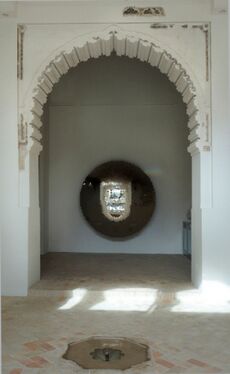
The Cathedral of Murcia was built between 1394 and 1465 in a style called Castilian Gothic. Its tall tower was finished in 1792 and shows a mix of different building styles. The bottom parts are from the Renaissance period, while the top part is Baroque. The bell tower mixes Rococo and Neoclassical styles. The main front of the cathedral (built 1736–1754) is a famous example of Spanish Baroque style.

Other important buildings around the cathedral square (Plaza Cardinal Belluga) include the colorful 'Bishop's Palace' from the 18th century. There's also a modern addition to the town hall designed by Rafael Moneo in 1999.
The Glorieta, located by the Segura River, has always been the heart of the city. It's a beautiful city square with gardens, built in the 18th century. Murcia's ayuntamiento (city hall) is in this square.
Many parts of the old town are for walking only. These areas are centered around Platería and Trapería Streets. Trapería Street goes from the cathedral to the Plaza de Santo Domingo, which used to be a busy market square. On Trapería Street, you'll find the Casino, a social club built in 1847. It has a fancy inside, including a Moorish-style patio that looks like the royal rooms of the Alhambra in Granada. The name Platería means "silver," because this street was where Murcia's Jewish community traded valuable metals. Trapería means "cloths," as this street was once where the Jewish community traded clothes.
Several bridges cross the Segura River. These include the Puente de los Peligros, an 18th-century stone bridge with a small chapel. There are also modern bridges designed by famous architects like Santiago Calatrava. The Puente Nuevo (new bridge) is an iron bridge from the early 20th century.
Other interesting places in and around Murcia include:
- Santa Clara monastery: This building shows both Gothic and Baroque styles. It has a museum with parts of a Moorish palace from the 13th century, called Alcázar Seguir.
- The Malecón boulevard: This used to be a wall to protect against floods from the Río Segura.
- Santuario de Nuestra Señora de la Fuensanta, Algezares (1694): A 17th-century holy place with a Baroque style and local Murcian touches. It's next to the El Valle regional park.
- Los Jerónimos monastery (18th century): Built in the early 1700s, it's in the Guadalupe district.
- Romea theatre (19th century): Opened by Queen Isabella II of Spain in 1862. It has a grand front with three levels.
- Circo theatre: Another historic theatre.
- Almudí Palace (17th century): This old building has coats of arms on its front. Inside, it has large columns. Since 1985, it holds the city's old records and hosts art shows.
- Monteagudo Castle (11th century): Located in the Monteagudo district, north of the city.
- Salzillo Museum: Shows the amazing art of Francisco Salzillo, a famous 18th-century sculptor from Murcia.
- Centro Párraga: A modern art center located in an old military building. It has many art shows, performances, and concerts all year.
- Archaeological Museum of Murcia (MAM): This museum tells the story of Murcia's past, from ancient times to the Christian and Visigoth periods.
- San Juan de Dios church-museum: A round Baroque and Rococo style church. In its basement, you can find parts of a Moorish palace mosque from the 12th century, called Alcázar Nasir.
In the wider Murcia area, you can also find the Azud de la Contraparada reservoir and the Noria de La Ñora water wheel.
Murcia's Fun Times: Festivals and Celebrations
The Holy Week procession in Murcia is one of the most famous in Spain. This old festival shows the events leading up to and including the Crucifixion from the New Testament. Large, detailed sculptures by Francisco Salzillo (who lived from 1707–1783) are taken from museums. They are carried through the city in beautiful parades, with flowers and candles at night. The parades stop at different points to act out the last moments before Jesus's crucifixion.
Murcia's most colorful festival happens one week after Holy Week. Locals dress in traditional huertano clothes to celebrate the Bando de la Huerta (Orchard parade) on Tuesday. Then, on the following Saturday, the streets fill up for The Burial of the Sardine in Murcia parade. This whole week is called Fiestas de Primavera de Murcia (Spring Fest).
Murcia's Three Cultures International Festival takes place every May. It was started to help people understand and respect different cultures. The festival celebrates the three cultures that have lived together in Spain for centuries: Christians, Jews, and Muslims. Each year, the festival features music, art shows, and talks about these three cultures.
Festivities in Murcia's Districts
Many other festivals are held throughout Murcia's different districts. These often include celebrations for their local patron saints. Some of these happen in June and September. A common activity is the Coronación de las reinas, where three young girls and three teenage girls are chosen as symbolic queens. Holy Week celebrations are also held in some districts on their own. Pasacalles (like parades) and desfiles de carrozas (parades with decorated floats) are also popular. Religious events include processions, where statues of the Patron Virgin are carried on platforms.
Murcia's Economy: Farming, Tourism, and More
Murcia's economy mainly focuses on farming and tourism. About 33.1% of the city's land is used for growing crops. In 2019, about 35.3% of job agreements were for farming and fishing jobs.
In 2019, about 7.79% of job agreements were for industry jobs. The service sector, which includes jobs like waiters, made up 53.12% of job agreements in 2019.
Murcia's economy also gets a boost from trade shows and conferences, museums, theaters, cinemas, music events, aquariums, restaurants, hotels, shopping centers, campsites, sports, and international students.
Getting Around Murcia: Transport Options
Roads for Travel
A main highway called A-30 connects Cartagena and Albacete and goes through Murcia. Another national highway, A-7, is in the northwest of Murcia. There's also a highway called MU-30, which connects Alcantarilla and the El Palmar district. Murcia also has 52 regional roads.
Flying to Murcia: Airports
Region of Murcia International Airport (RMU) is about 20 km (12 miles) south of the city. It has flights to different countries and within Spain. It opened on January 15, 2019. Alicante–Elche International Airport is 60 km (37 miles) northeast of Murcia. This is the 5th busiest airport in Spain, with 15 million passengers each year.
Bus Services in Murcia
Bus services between towns are run by LatBus. Buses within the city are provided by a new company called Transportes de Murcia.
Murcia's Tram System
The Murcia tram system is managed by Tranvimur. As of 2020, there were 17.5 km (10.9 miles) of tram lines. Two lines connect the city center (Plaza Circular) to the University Campus and the Football Stadium. Another line connects Espinardo to UCAM and Los Jerónimos.
Train Connections from Murcia
Train services are provided by Renfe. Murcia has a train station called Murcia del Carmen. It connects the city to Madrid (through Albacete), Valencia, and Catalonia, even reaching Montpellier in France. Murcia is also a hub for local trains. Line C-1 connects to Alicante, and line C-2 connects Murcia to Alcantarilla, Lorca, and Águilas. There are also regional lines to Cartagena, Valencia, and Zaragoza.
Staying Healthy in Murcia: Healthcare
Hospitals and public health centers in Murcia are part of the Murcian Healthcare Service. There are three public hospitals in Murcia:
- Hospital Clínico Universitario Virgen de la Arrixaca in El Palmar, which has special units for babies and children.
- Hospital General Universitario Reina Sofía: Located in the main city, next to the Segura River.
- Hospital Morales Meseguer: Also located in the main city.
Most of Murcia belongs to Health Area I, centered in the main town. However, some districts in the northeast are in Health Area VII, and Cabezo de Torres district is in Health Area VI.
Learning in Murcia: Education
Murcia has three universities:
- Two public universities: the University of Murcia, started in 1272, and the Universidad Politécnica de Cartagena.
- One private university: the Catholic University Saint Anthony, started in 1996.
There are also many high schools, elementary schools, and professional schools. Murcia has three types of schools for children:
- Private schools: These include international schools like El Limonar International School, Murcia (a British school) and The American School of Murcia. Other private schools include Nelva (a religious school) and San Jorge (a secular bilingual Spanish school).
- Semi-private schools (concertado): These are private schools that get some money from the government. They sometimes offer religious lessons.
- Public schools: These are strictly secular (non-religious) schools, like Colegio Publico (CP) San Pablo or IES Licenciado Francisco Cascales. CP Cierva Peñafiel is one of the oldest public schools.
The French international school, Lycée Français André Malraux de Murcie, is in a nearby town called Molina de Segura.
Murcia also offers Adult Education. This helps people who want to finish high school or go on to university later in life.
Famous People from Murcia
- Ibn al-Raqqam (1250-1315), an astronomer, doctor, and mathematician.
- Muhyī al-Dīn Ibn al-'Arabī (1165–1240), a very important Islam Sufi master and writer.
- Nicolás Almagro (1985–), a tennis player.
- Carlos Alcaraz (2003–), a tennis player.
- Juan de la Cierva (1895–1936), who invented the autogyro, an early type of helicopter.
- Diego de Saavedra Fajardo (1584–1648), a writer and diplomat.
- Ramón Gaya (1910–2005), a painter and writer.
- Ruth Lorenzo (1982–), a singer.
- José Moñino, conde de Floridablanca (1728–1808), an important statesman who worked for King Charles III of Spain.
- Francisco "Paco" Rabal (1926–2001), a famous actor.
- Francisco Salzillo (1707–1783), a Baroque sculptor.
- Alejandro Valverde (1980–), a cyclist.
Murcia's Sports Teams
Here are some of the sports teams from Murcia:
- Real Murcia – a football (soccer) team founded in 1908. They play in the Primera Federación league.
- UCAM Murcia – another football team.
- CB Murcia – a basketball team owned by the UCAM private university. They play in Spain's top basketball league, the Liga ACB.
- ElPozo Murcia Turística FS – a futsal (indoor soccer) team founded in 1992. They play in the first division.
- CAV Murcia 2005 – a volleyball team. They won several titles before ending in 2011.
- Origen (esports) – a well-known League of Legends esports team in Spain, founded in 2014.
Murcia's Sister Cities
Murcia has special friendly relationships with other cities around the world. These are called twin towns or sister cities:
Images for kids
See also
 In Spanish: Murcia para niños
In Spanish: Murcia para niños




